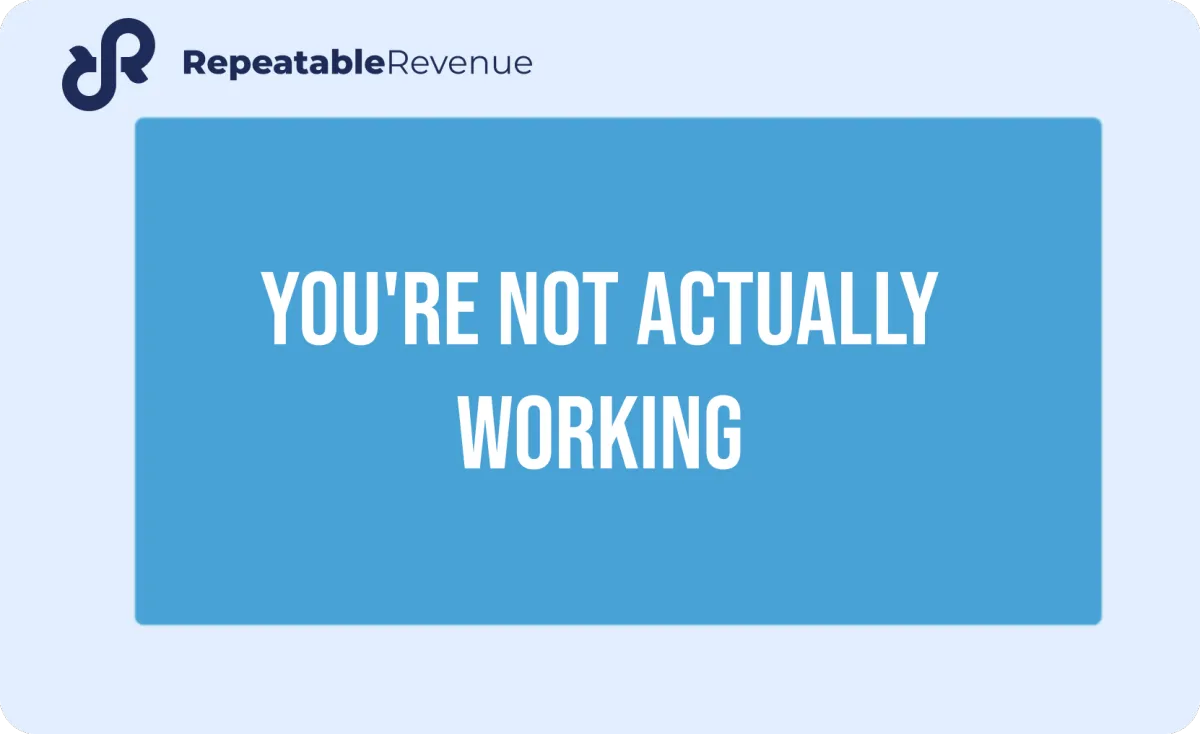
You're not actually working
I've done this more times than I care to admit.
Poured weeks—sometimes months—into projects, initiatives, or strategies. Tons of activity. Endless hustling. Mountains of effort.
Only to realize, nothing was actually moving forward.
I see the same pattern everywhere now. Business owners grinding 60-hour weeks with nothing to show for it. Sales reps making hundreds of calls that go nowhere. Businesses stuck at the same revenue for years despite massive investment of time and money.
It's not laziness. It's not lack of effort.
It's something more fundamental—and physics explains exactly why it happens.
The Science of “Work”
In physics, “work” literally has a simple equation:
Work = Force × Distance × cos(θ)
Don’t worry—we’re not going full science class here. Just replace “theta” with alignment, and this formula becomes a powerful tool for business and life.
Let me break these down in real world terms for business (and life):
Force = The effort you're putting in. The hours. The energy. The inputs.
Think: number of calls you're making, reps at the gym, hours spent writing, meetings scheduled.
Distance = The movement that happens as a result of that force. The outputs.
Think: appointments booked, muscle gained, pages written, meetings held.
For most people, the equation stops there. You go, "I made 100 calls and booked 10 meetings—I did ‘work’!" Or "I put in the hours at the gym—I did ‘work’!"
But here's where it gets interesting.
Alignment = Whether that movement actually gets you closer to your real goal.
And this is the part that fucks everyone up.
The Wall That Won't Move Your Business Forward
Here's the classic physics example:
Say I push a wall with everything I've got. I'm sweating, straining, pouring in effort. And somehow, I move that wall 15 feet.
I put in work, right?
But what if I pushed the wall that way when I needed it to go the other way?
Physics says: no real work was done.
You invested massive effort (force). You got movement (distance). But it wasn't aligned with the outcome you actually needed.
Now apply this to where you actually put “work” in:
Made 500 calls → Booked 50 appointments → Closed zero deals? No real work.
Spent months building a product feature nobody asked for? No real work.
Added muscle at the gym when your actual goal was fat loss? No real work.
Wrote 200 pages of a book that never gets published? No real work.
If alignment is zero, the output is zero—no matter how much force or distance you generated.
That's a bitter pill to swallow when you've invested a shitload of time and energy.
Why Platitudes Are All Wrong
Once you understand this equation, you start to see why the two most popular approaches to productivity are both incomplete.
On one side, you've got the grind-it-out crowd.
On the other, the "work smarter not harder" evangelists.
Both are half right. Both are half wrong.
Hustle culture gets it wrong because they obsess over force.
Work harder, more hours, more calls, more reps, more grind.
But if the movement isn't aligned with your actual outcome? You're just pushing walls in the wrong direction.
The "work smarter not harder" crowd also misses it because they undervalue force.
They'll tell you to do a few hours of deep work and then go drink margaritas on the beach.
Focus and leverage are great—I'm a huge believer in both.
But if you're not applying enough force, or worse, if what you're focused on isn't aligned with the real goal? Still no real work.
The equation requires all three variables.
It's not either/or. It's physics.
How to Actually Do More Real Work
So how do you make sure you're not just busy, but actually moving the needle?
Three things:
1) Clarify the real goal.
In sales, "appointments booked" is not the real goal. The real goal is closed deals—which means you need qualified appointments that turn into proposals that actually close.
Work backward from the true outcome. What does success actually look like?
2) Define your movement metrics.
Figure out what you can measure to know if you're moving in the right direction:
Appointments sat (not just booked)
Qualified discovery calls
Proposals sent
Deals closed
These tell you if the distance you're creating is real progress and properly aligned.
3) Apply the necessary force.
Then decide the inputs necessary to put in—calls, outreach, demos, hours executing—and adjust based on whether those movement metrics are trending the right way.
When you do this properly, you know the goal (alignment), you know the progress markers (distance), and you're putting in the work to get there (force).
That's when effort actually converts to results.
The Bottom Line
I see this mistake everywhere:
Founders grinding 80-hour weeks on the wrong priorities.
Sales reps making hundreds of calls to unqualified prospects.
Marketers optimizing metrics that don't drive revenue.
All effort. Lots of movement. Zero alignment.
And then they wonder why nothing's working.
Physics doesn't care about your effort. It doesn't even care about your motion.
Real work = Force × Distance × Alignment.
Get all three right and your output compounds.
Miss even one and you stall—or worse, you charge full speed in the wrong direction.
It's not complicated. It's just physics.
Adios,
Ray
P.S. — Speaking of alignment: I recently decided to make significant changes to my content creation process to keep it fun for me. Part of that means going all in on my podcast—publishing unfiltered takes on everything from business to lifestyle to fitness. I shipped a new episode to my editors every day this week. Turns out when you're aligned with what you actually want to create, the force comes easy. Follow along if you’d like here: Spotify | Apple | Other platforms
